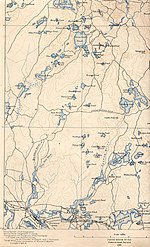Mill Pond (Wareham, Massachusetts)
Plymouth County, Massachusetts geography stubsPonds of MassachusettsPonds of Plymouth County, MassachusettsWareham, Massachusetts

Mill Pond, also known unofficially as Agawam Mill Pond, is a 150-acre (0.61 km2) pond in Wareham, Massachusetts. The pond is located northwest of Union Pond, west and north of Spectacle Pond, west of Sandy Pond, and southwest of Glen Charlie Pond. The Agawam River runs through the pond. Route 25 runs through the southwestern part of the pond, and the Exit 2 off-ramp from Route 25 eastbound lies along the shore en route to Glen Charlie Road, which runs along the pond's eastern shore.
Excerpt from the Wikipedia article Mill Pond (Wareham, Massachusetts) (License: CC BY-SA 3.0, Authors, Images).Mill Pond (Wareham, Massachusetts)
Agawam Lake Shore Drive,
Geographical coordinates (GPS) Address Nearby Places Show on map
Geographical coordinates (GPS)
| Latitude | Longitude |
|---|---|
| N 41.770833333333 ° | E -70.671944444444 ° |
Address
Agawam Lake Shore Drive 89
02571
Massachusetts, United States
Open on Google Maps






